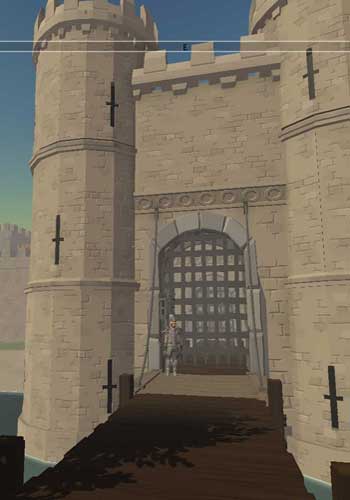 n abbey was founded on the site around 655 by either Saxulf or Peada the first Christian king of Mercia. The abbey was consecrated by the Archbishop of Canterbury in 655. At the end of the 9th century the Danes invaded and raised the abbey to the ground. The abbey lay in ruins until the Aethelwold, Bishop of Winchester, with help from King Edgar rebuilt the abbey and consecrated it in 972 in the presence of Archbishops Dunstan of Canterbury and Oswald of York. The second abbey was run under the rule of the Benedictines. The abbey, dedicated to St. Peter, had a wall built around it for defence and the name changed to Burgh St. Peter where Burgh means fortified. In 1066 Leofric, the abbot of Peterborough, stood at Harold's side at Hastings but was wounded and died. His successor Brando mistakenly supported Edgar the Atheling instead of William the Conqueror and when William enforced his rule Brando had to pay him a fine. A Norman abbot was installed at Peterborough when Brando died in 1069. In 1116 fire struck the abbey and the building was badly damaged. Rebuilding work began in 1118 and took 120 years to complete. The building was consecrated in 1238 by the Bishop of Lincoln, Grosseteste. The abbey became a Cathedral in 1541 after the abbeys were dissolved in 1539. Notable people to be buried here are Catherine of Aragon who was divorced from King Henry VIII and Mary Queen of Scots who was buried here before being moved to Westminster Abbey.
n abbey was founded on the site around 655 by either Saxulf or Peada the first Christian king of Mercia. The abbey was consecrated by the Archbishop of Canterbury in 655. At the end of the 9th century the Danes invaded and raised the abbey to the ground. The abbey lay in ruins until the Aethelwold, Bishop of Winchester, with help from King Edgar rebuilt the abbey and consecrated it in 972 in the presence of Archbishops Dunstan of Canterbury and Oswald of York. The second abbey was run under the rule of the Benedictines. The abbey, dedicated to St. Peter, had a wall built around it for defence and the name changed to Burgh St. Peter where Burgh means fortified. In 1066 Leofric, the abbot of Peterborough, stood at Harold's side at Hastings but was wounded and died. His successor Brando mistakenly supported Edgar the Atheling instead of William the Conqueror and when William enforced his rule Brando had to pay him a fine. A Norman abbot was installed at Peterborough when Brando died in 1069. In 1116 fire struck the abbey and the building was badly damaged. Rebuilding work began in 1118 and took 120 years to complete. The building was consecrated in 1238 by the Bishop of Lincoln, Grosseteste. The abbey became a Cathedral in 1541 after the abbeys were dissolved in 1539. Notable people to be buried here are Catherine of Aragon who was divorced from King Henry VIII and Mary Queen of Scots who was buried here before being moved to Westminster Abbey.| County | Categories | ||
| Remains | Excellent remains | Access | Only open at certain times |
| Location | 52.56149,-0.23208 (Google Maps) ///stews.spare.carry | Directions | Directions via Google Maps |
| County |
| Categories |
| Remains |
Excellent remains |
| Access |
Only open at certain times |
| Location |
| 52.56149,-0.23208 ///stews.spare.carry |
| Directions |
| Directions via Google Maps |
 n abbey was founded on the site around 655 by either Saxulf or Peada the first Christian king of Mercia. The abbey was consecrated by the Archbishop of Canterbury in 655. At the end of the 9th century the Danes invaded and raised the abbey to the ground. The abbey lay in ruins until the Aethelwold, Bishop of Winchester, with help from King Edgar rebuilt the abbey and consecrated it in 972 in the presence of Archbishops Dunstan of Canterbury and Oswald of York. The second abbey was run under the rule of the Benedictines. The abbey, dedicated to St. Peter, had a wall built around it for defence and the name changed to Burgh St. Peter where Burgh means fortified. In 1066 Leofric, the abbot of Peterborough, stood at Harold's side at Hastings but was wounded and died. His successor Brando mistakenly supported Edgar the Atheling instead of William the Conqueror and when William enforced his rule Brando had to pay him a fine. A Norman abbot was installed at Peterborough when Brando died in 1069. In 1116 fire struck the abbey and the building was badly damaged. Rebuilding work began in 1118 and took 120 years to complete. The building was consecrated in 1238 by the Bishop of Lincoln, Grosseteste. The abbey became a Cathedral in 1541 after the abbeys were dissolved in 1539. Notable people to be buried here are Catherine of Aragon who was divorced from King Henry VIII and Mary Queen of Scots who was buried here before being moved to Westminster Abbey.
n abbey was founded on the site around 655 by either Saxulf or Peada the first Christian king of Mercia. The abbey was consecrated by the Archbishop of Canterbury in 655. At the end of the 9th century the Danes invaded and raised the abbey to the ground. The abbey lay in ruins until the Aethelwold, Bishop of Winchester, with help from King Edgar rebuilt the abbey and consecrated it in 972 in the presence of Archbishops Dunstan of Canterbury and Oswald of York. The second abbey was run under the rule of the Benedictines. The abbey, dedicated to St. Peter, had a wall built around it for defence and the name changed to Burgh St. Peter where Burgh means fortified. In 1066 Leofric, the abbot of Peterborough, stood at Harold's side at Hastings but was wounded and died. His successor Brando mistakenly supported Edgar the Atheling instead of William the Conqueror and when William enforced his rule Brando had to pay him a fine. A Norman abbot was installed at Peterborough when Brando died in 1069. In 1116 fire struck the abbey and the building was badly damaged. Rebuilding work began in 1118 and took 120 years to complete. The building was consecrated in 1238 by the Bishop of Lincoln, Grosseteste. The abbey became a Cathedral in 1541 after the abbeys were dissolved in 1539. Notable people to be buried here are Catherine of Aragon who was divorced from King Henry VIII and Mary Queen of Scots who was buried here before being moved to Westminster Abbey.Location
See Also
People
Other
Related Information
Related Maps
Related Episodes
Viking Invasions (click here)
Norman Conquest (click here)
Henry VIII and his Six Wives (click here)
Timeline
869
...
Danes attack East Anglia
Moving south again from York, The Danes entered East Anglia, attacking and destroying the many religious buildings in the area including the monastery at was what to become Peterborough. The King of East Anglia, Edmund raised an army to attack the Danes but was captured and killed. [1]
972
...
Consecration of Peterborough Abbey
Dunstan, the Archbishop of Canterbury, and Oswald, the Archbishop of York, consecrated the abbey at Peterborough in the presence of King Edgar.
1070
June
Hereward the Wake sacks Peterborough Abbey
As part of a revolt against the new Norman invaders, Hereward the Wake sacked the abbey at Peterborough.
1102
...
Peterborough Cathedral attacked
The monastery at Peterborough was attacked by Flemish mercenaries. They broke into the buildings and took anything of value made of gold and in silver including crosses, chalices and candlesticks. [2]
1117
(to 1155)
Peterborough Cathedral choir and transept
After the devastating fire of 1116 work began on rebuilding the abbey at Peterborough. The central area including choir and transept were begun first. Work continued until 1155. [3]
1155
(to 1175)
Peterborough Cathedral Nave
The nave of Peterborough Cathedral was the next phase of rebuilding work after the choir and transept. Work continued until 1175. [3]
1193
(to 1230)
West Front of Peterborough Cathedral
The West front of Peterborough Cathedral was constructed between the years 1193 and 1230. [3]
1216
...
King John at Peterborough
King John and his army may have plundered Peterborough as they travelled through the area on the way north.
1238
...
Peterborough Church consecrated
The buildings at Peterborough must have been complete enough for them to be consecrated. The ceremony was conducted by the Bishop of Lincoln.
1272
(to 1286)
Peterborough Cathedral's Lady Chapel
The Lady Chapel of the Cathedral at Peterborough was constructed between 1272 and 1286. [3]
1325
...
Peterborough's Central Tower
The central tower of Peterborough Cathedral was begun in 1325. [3]
1375
...
Galilee porch as Peterborough
Construction of the Galilee porch on the West front of Peterborough Cathedral was started in 1375. [3]
1536
January
Death of Catherine of Aragon
Catherine of Aragon died. It was believed that she had been poisoned but it is possible that she died of cancer. Catherine died at Kimbolton Castle. Her body was moved to Peterborough Cathedral where she was buried on the 29th of the month.
1539
...
Peterborough Abbey dissolved
The abbey at Peterborough was dissolved like many other abbeys across England by the order of King King Henry VIII. Many of the monks were expelled and a new establishment was installed headed by a Bishop, thus converting Peterborough into a cathedral.
1587
August
Mary buried at Peterborough
On the order of Queen Elizabeth, Mary, Queen of Scots was buried in the Cathedral several months after having been executed at nearby Fotheringhay Castle.


3D Virtual Reconstructions
Transport yourself back up to a thousand years and explore historical buildings as they may have appeared in the past. Built using the popular game development tool Unity 3D, these reconstructions will run in the most of the popular web browsers on your desktop or laptop computer.
Page Navigation
Selection of references used:
- 1: Ronald McNair Scott, Alfred the Great, ISBN:0-86332-832-6
- 2: JohnHarwood Hill B.A., Chronical of the Christian Ages
- 3: John Harvey, English Cathedrals, 1961, Batsford (1961)
Location
See Also
People
Other
Related Information
Related Maps
Explore the White Tower
Explore all four floors of the White Tower at the Tower of London using the Unity 3d game engine.
A Medieval Mystery
There appear to be some strange connections between the fourteenth century Old Wardour Castle and ancient stone circle Stonehenge.

1: Location
Old Wardour Castle appears to be aligned to ancient sites in the Stonehenge landscape.
2: Alignment
Stonehenge is aligned to the Summer Solstice. Old Wardour has a very similar alignment.
3: Size
Could the builders of Old Wardour used mesaurements from Stonehenge to layout the geometrical keep?
Learn More














